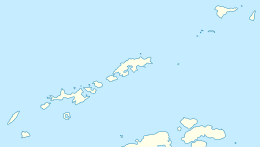 Smith island with Imeon Range in the background | |
 Topographic map of Smith Island | |
| Geography | |
|---|---|
| Location | Antarctica |
| Coordinates | 63°00′S 62°30′W / 63.000°S 62.500°W |
| Archipelago | South Shetland Islands |
| Area | 148 km2 (57 sq mi) |
| Length | 20 mi (30 km) |
| Width | 5 mi (8 km) |
| Highest elevation | 2,025 m (6644 ft) |
| Highest point | Mount Foster |
| Administration | |
| Administered under the Antarctic Treaty System | |
| Demographics | |
| Population | 0 |
Smith Island is 20 miles (32 km) long and 5 miles (8 kilometres) wide, lying 49 miles (79 km) west of Deception Island in the South Shetland Islands of the British Antarctic Territory. It is separated from Snow Island by the 25 miles (40 km)-wide Boyd Strait, and from Low Island by the 17 miles (27 km)-wide Osmar Strait. Surface area is 148 square kilometres (57 sq mi).[1]
The discovery of the South Shetland Islands was first reported in 1819 by Capt. William Smith, after whom the island is named. This island was known to both American and British sealers as early as 1820, and the name Smith has been well established in international usage for over 100 years, although in Russian literature it is often referred to as Borodino Island, sometimes marked as Borodino (Smith) Island.
The island hosts no research stations or camps, and is seldom visited by scientists or mountaineers. Its interior is entirely occupied by the Imeon Range, rising to 2,025 m (6,644 ft) (Mount Foster).[2][3] The first detailed topographic mapping of the island was made by the Antarctic Place-names Commission and the Military Geographic Service of the Bulgarian Army[4] and published in 2009[1] in both English and Bulgarian.
- ^ a b L.L. Ivanov. Antarctica: Livingston Island and Greenwich, Robert, Snow and Smith Islands. Scale 1:120000 topographic map. Troyan: Manfred Wörner Foundation, 2010. ISBN 978-954-92032-9-5 (First edition 2009. ISBN 978-954-92032-6-4)
- ^ Bulgarian Antarctic Gazetteer
- ^ I.M. Howat, C. Porter, B.E. Smith, M.-J. Noh and P. Morin. Reference Elevation Model of Antarctica (REMA). Polar Geospatial Center. University of Minnesota, 2022 (Antarctic REMA Exlorer)
- ^ L. Ivanov and N. Ivanova. South Shetlands. In: The World of Antarctica. Generis Publishing, 2022. pp. 23-24. ISBN 979-8-88676-403-1

